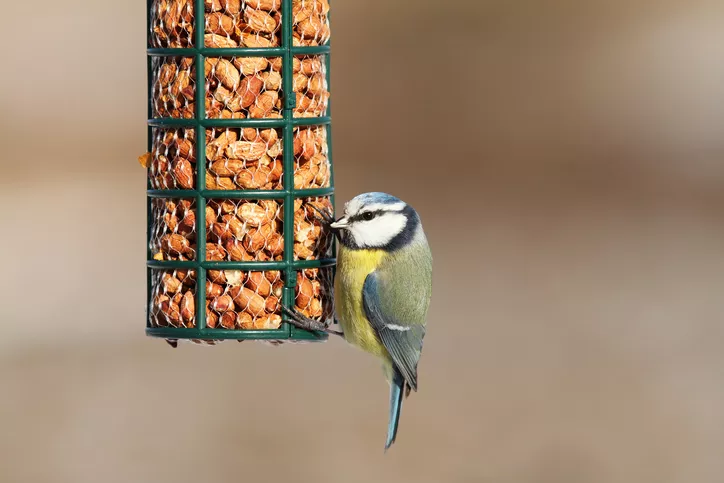- Feed silos: the plus when it comes to hygiene
- But: Which food is actually at the top of the menu for the feathered guests? Here is a brief overview:
- Always keep cats and rats away from food
The feeding of birds in winter has a long tradition in this country and is nevertheless quite controversial. The Naturschutzbund Deutschland e. V. is of the opinion that feeding the animals, especially in winter, is advisable from an environmental educational point of view. Well-known scientists, such as the ornithologist Prof. Dr. Bertold even recommend feeding the birds well into the summer. However, critics are of the opinion that the natural selection mechanism would be disturbed if we simply put the food in front of the animals on a silver platter.
 Blue tits like peanuts
Blue tits like peanuts
We believe that you should do exactly what you think is right. Nevertheless, we would like to give you some advice to take with you over the winter as far as the correct and sensible feeding of blackbirds, thrushes, finches and tits is concerned.
Feed silos: the plus when it comes to hygiene
These feeders have the advantage that the birds do not have the opportunity to walk around in the feed and contaminate it with their droppings. This counteracts any transmission of pathogens and the feed spread out in the storage silo cannot spoil, even over a longer period of time. It should be noted that the feed dispensers are placed in such a way that they are largely protected from precipitation and that no rot can form inside. Apart from the occasional cleaning of the storage container and refilling with feed that is as dry as possible, no further maintenance work is necessary.
But: Which food is actually at the top of the menu for the feathered guests? Here is a brief overview:
- Blue tit: chopped peanuts, sunflower seeds;
- Robins: chopped nuts, mealworms, raisins in coconut fat;
- green woodpecker: apples, greased peanuts;
- Magpie: whole peanuts, corn kernels;
- Greenfinch: chopped nuts; sunflower seeds, poppy seeds and hemp seeds;
- Blackbird: apples, oatmeal, raisins, dried berries, peeled sunflower seeds;
- nuthatch: cereal flakes, hemp, hazelnuts, sunflower seeds;
- Goldfinch: seeds of faded perennials, sunflower seeds, chopped nuts;
- jay, corn kernels, acorns, whole peanuts;
Sunflower seeds are the basic feed that almost all birds love and you can't go wrong with any of the commercially available feed mixes either. As grain eaters, tits are particularly fond of plant seeds, which are stored in fat and are commercially available as tit rings. It is very easy to make them yourself, but if you buy one, use one without a plastic net if possible, as the animals often injure their legs. Salty foods, especially bacon and boiled potatoes, should be avoided entirely. Bread is also taboo for birds, as it is too bloating in the animal's digestive system.
Always keep cats and rats away from food
Although birds naturally recognize and react to danger very quickly, bird houses should be attached to a sufficiently high (at least 1.50 meters) and not too thick pole in the ground. In a pinch, a cat protection belt or grid underneath the house also helps to slow down the four-legged intruders. Care should also be taken when food is dropped or left on the ground or scattered to feed the birds. Rats are attracted to this fairly quickly, so be sure to remove leftover food regularly.
tips
Clean your bird feeder regularly, even in winter, to keep pathogens away from the animals. And: It is best to place a suitable drinking trough near the food source, which must be kept free of ice, especially in frosty temperatures.